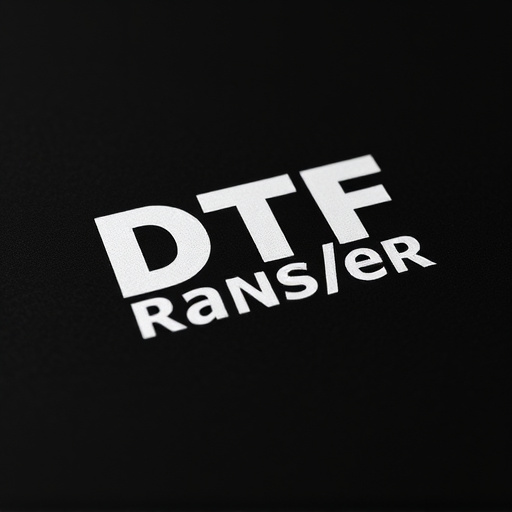Direct to Film (DTF) transfer technology revolutionizes printing with its speed, versatility, and durability. It directly applies designs to film, enabling swift turnaround times and high-quality prints on various materials. The cooling process is crucial for ensuring the ink cures correctly, enhancing durability and vibrancy. Setting up a DTF station involves securing reliable equipment, consumables, and software. Following meticulous steps and precise controls guarantees successful DTF transfers for art and industrial applications, allowing artists and businesses to bring their designs to life promptly and with exceptional quality.
“Unleash your creativity with the revolutionary power of DTF Transfer (Direct-to-Film), a process transforming various industries. This comprehensive guide dives into the ins and outs of DTF Printing, offering a detailed DTF Transfer overview. From understanding the cooling process, essential for achieving crisp DTF Prints, to exploring suitable materials and equipment, we provide a step-by-step approach.
Learn from common mistakes, discover diverse applications, and unlock the potential of this cutting-edge technology, making your next DTF Transfer project a success.”
- Understanding DTF Transfer: A Comprehensive Overview
- The Cooling Process: Why It's Crucial for DTF Prints
- Materials and Equipment Required for DTF Printing
- Step-by-Step Guide to Executing a Successful DTF Transfer
- Common Mistakes to Avoid in DTF Transfer and Printing
- Applications of DTF Transfers: From Art to Industry
Understanding DTF Transfer: A Comprehensive Overview

A DTF (Direct to Film) transfer is a cutting-edge printing technique that has revolutionized the way we approach custom printing and imaging. Unlike traditional methods, DTF technology enables the direct application of designs onto film, eliminating the need for intermediate steps. This process is particularly valuable in industries like signmaking, graphics, and promotional merchandise, where high-quality, durable prints are required. By employing a DTF transfer, businesses can achieve vibrant colors, crisp details, and long-lasting results on various materials, from vinyl banners to t-shirts.
DTF Printing offers a range of benefits, including speed, versatility, and cost-effectiveness. The printing process is swift, allowing for quick turnaround times, which is essential in dynamic markets. Additionally, DTF technology supports a diverse array of print media, ensuring that businesses can cater to different customer needs. From indoor signage to outdoor advertising, DTF prints prove their worth by providing consistent quality across various applications. This advanced technique has truly elevated the standards of printing and continues to be a game-changer in the industry.
The Cooling Process: Why It's Crucial for DTF Prints

The cooling process is an integral part of DTF (Direct to Film) transfer technology. After a DTF print is applied to a substrate, it must cool down completely before removal. This step is crucial for several reasons. First, allowing the adhesive layer to set properly ensures the printed design adheres firmly to the material without any issues or blisters forming beneath. Second, cooling enables the ink to cure, enhancing its durability and resistance to fading, ensuring vibrant colors and a high-quality finish for the final product.
A proper cooling period also prevents warping or deformation of the substrate, which can occur if the print is attempted to be removed too soon. This meticulous step in DTF printing guarantees that the transfers are not only visually appealing but also long-lasting, making them suitable for various applications, from decorative items to promotional products.
Materials and Equipment Required for DTF Printing

To embark on the journey of creating DTF (Direct to Film) transfers, several key materials and pieces of equipment are essential. The process demands a specific setup to ensure precise and high-quality prints. Firstly, you’ll need a reliable DTF printer, capable of delivering fine details and vibrant colours. These printers use a direct imaging method, allowing for accurate representations of your design on the film.
Alongside the printer, gather the necessary consumables: DTF transfer film, suitable for your printer’s technology, and a high-resolution digital image file prepared specifically for DTF printing. The right software for image editing and cutting is also critical. Moreover, don’t overlook the importance of protective gear, as handling the materials requires safety precautions.
Step-by-Step Guide to Executing a Successful DTF Transfer

A Direct to Film (DTF) transfer is a precise and efficient method for creating prints directly from digital art, offering exceptional quality for a range of applications. Here’s a step-by-step guide to ensure your DTF process is successful:
1. Preparation: Start by preparing your artwork in the correct format. Ensure it’s high-resolution and optimized for printing. Convert your design into a format compatible with your chosen DTF software, typically a vector graphic or a high-resolution raster image. Adjust settings like resolution, color mode, and line quality to align with your desired print outcome.
2. Software and Plate Setup: Launch the DTF software and load your prepared art file. Calibrate your plate or film according to manufacturer instructions, ensuring accurate exposure. Set printing parameters, including resolution, dot size, and exposure time, based on the type of ink and material you’re using. Fine-tune these settings through test prints to achieve optimal results.
3. Ink Application: Choose the appropriate ink for your project and load it into the printer or DTF machine. Ensure proper flow and consistency by conducting a test print before beginning your main batch.
4. Printing Process: Position your film or plate correctly within the printing unit, following guidelines to maintain registration accuracy. Initiate the print job, monitoring the process closely for any issues. Maintain consistent temperature and pressure throughout as these factors significantly impact image quality and adhesion.
5. Cooling and Removal: After printing, allow the film or plate to cool completely according to manufacturer recommendations. Once cooled, carefully remove the transfer from its substrate, ensuring a clean separation for optimal application onto your desired surface.
Common Mistakes to Avoid in DTF Transfer and Printing

When attempting a DTF (Direct to Film) transfer and printing, there are several common mistakes that can negatively impact the final results. One of the most frequent errors is insufficient preparation of the film surface before application. It’s crucial to ensure the film is clean, free from dust or debris, and has a smooth finish for optimal adhesion. Skipping this step may lead to bubbles, gaps, or an uneven transfer layer.
Another mistake to avoid is improper timing during the cooling process. DTF transfers require precise temperature and time control to cure correctly. Over-cooling can result in cracks or delaminations while under-cooling might leave residue or cause smudging of the printed image. Maintaining the recommended cooling time ensures strong adhesion and vibrant, long-lasting DTF prints.
Applications of DTF Transfers: From Art to Industry

DTF Transfers, or Direct to Film transfers, have a wide range of applications, from artistic endeavors to industrial uses. In the realm of art, DTF Printing offers artists a unique way to create and reproduce intricate designs with precision and vibrancy. The process allows for direct imaging onto various materials, enabling the production of limited-edition prints, custom artwork, and even wearable items like T-shirts and accessories.
Industrially, DTF Transfers are utilized in manufacturing for prototyping and small-batch production. They facilitate the creation of personalized products, such as custom phone cases, accessories, and promotional items. Moreover, their rapid production time and flexibility make them ideal for businesses needing to quickly adapt to market demands or create unique, one-off gifts and keepsakes. DTF Prints have truly revolutionized the way we bring designs from concept to physical form, offering both artists and industries a dynamic and versatile tool.














